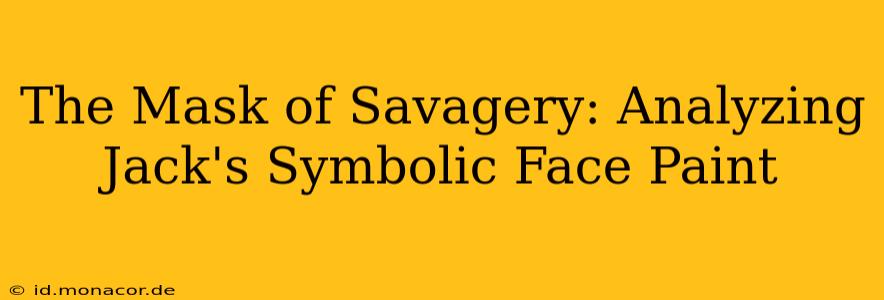William Golding's Lord of the Flies is a chilling exploration of human nature, where a group of British schoolboys stranded on a deserted island descend into savagery. Central to this descent is Jack Merridew, whose transformation is powerfully symbolized by his increasingly elaborate face paint. This essay will delve into the symbolic meaning of Jack's face paint, exploring its evolution and its role in representing the disintegration of civilization and the rise of primal instincts.
What does Jack's face paint symbolize in Lord of the Flies?
Jack's face paint serves as a powerful visual metaphor for his evolving personality and the escalating savagery of the boys. Initially, it's a simple, almost playful application, a rudimentary attempt at camouflage during hunts. However, as his power grows and his adherence to societal norms diminishes, the paint becomes more elaborate, more ritualistic, and ultimately, more terrifying. The paint acts as a mask, concealing his true identity and allowing him to shed the constraints of civilized behavior. It's a deliberate act of self-transformation, a conscious choice to embrace primal instincts.
How does Jack's face paint change throughout the novel?
The evolution of Jack's face paint mirrors his descent into savagery. Starting with simple streaks, it gradually becomes more complex and symbolic. The initial, rudimentary paint represents a desire for conformity to a perceived hunter role, mimicking the behaviors of "primitive" cultures he might have read about. As he embraces his newfound power, the paint becomes bolder, more defined, and more aggressive. The colors and patterns themselves take on new significance, acting as a visual representation of his growing detachment from civilization and his increasing embrace of violence. The final, fully painted face is a grotesque parody of humanity, a horrifying testament to the boys' complete loss of innocence.
What is the significance of the paint's color?
While Golding doesn't explicitly detail specific colors, the implication is that the paint is earthy tones—browns, blacks, and reds—evoking the natural world and the primal instincts that reside within. The colors themselves aren't simply decorative; they represent a connection to the land, a rejection of the artificiality of civilization. The darker hues might also symbolize the encroaching darkness and moral decay within the boys' hearts. The potential presence of red, especially, suggests bloodshed and violence, mirroring the escalating brutality of Jack's tribe.
Does Jack's face paint represent a loss of identity?
Ironically, while the paint initially acts as a mask, concealing Jack's true identity, it ultimately reveals a deeper truth. It reveals the savagery that lay dormant within him, stripped bare of the veneer of civilization. He sheds his name, becoming simply "Jack," the hunter, the leader of a tribe operating outside the confines of law and morality. His face paint becomes his new identity, a symbol of his primal self, freed from the constraints of societal expectations.
Does the face paint contribute to the boys' dehumanization?
Absolutely. The face paint is not just a personal transformation for Jack; it also contributes to the dehumanization of the entire tribe. By painting their faces, the boys are symbolically shedding their humanity, adopting a tribal identity that fosters violence and brutality. The act of painting itself becomes a ritualistic process, further separating them from their past selves and reinforcing their savage identity. The paint transforms them into something less than human, allowing them to commit atrocities without the constraints of moral conscience.
What is the ultimate symbolic meaning of Jack's face paint?
The ultimate symbolic meaning of Jack's face paint is the terrifying potential for savagery inherent within human nature. It's a visual representation of the fragility of civilization and the ease with which societal norms can be discarded when confronted with primal instincts. The transformation from a simple application of paint to a grotesque mask perfectly mirrors the boys' descent into chaos, highlighting the dangers of unchecked power and the enduring appeal of primal urges. It serves as a stark warning against the seductive power of savagery and the importance of maintaining the structures of civilized society.

